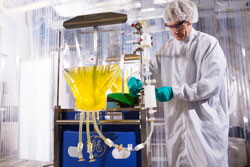 Increasing product titers in upstream cell culture processes pose challenges to downstream purification processes. For efficient operations, downstream purification needs to be able to handle high product titers at short process time. Compared with conventional chromatography, using stainless steel columns, the use of ReadyToProcess Adsorber membranes can help reduce capital investment, consumption of buffers and other process liquids for cleaning and storage, as well as process time, for example, by minimizing the need for cleaning and validation operations and by allowing for higher flow rates.
Increasing product titers in upstream cell culture processes pose challenges to downstream purification processes. For efficient operations, downstream purification needs to be able to handle high product titers at short process time. Compared with conventional chromatography, using stainless steel columns, the use of ReadyToProcess Adsorber membranes can help reduce capital investment, consumption of buffers and other process liquids for cleaning and storage, as well as process time, for example, by minimizing the need for cleaning and validation operations and by allowing for higher flow rates.
While sometimes perceived as costly, these ready-to-use products minimize the need for hardware qualification and cleaning validation, which can be rather costly and timeconsuming for biomanufacturers. By minimizing the need for cleaning operations, thereby reducing the changeover time between campaigns, ReadyToProcess Adsorber membranes allow for more batches to be produced per year, improving facility utilization and thus the profit opportunity. Compared with facilities using stainless steel columns, the use of disposable ReadyToProcess Adsorber membranes minimizes the number of non-value-adding steps in process development, such as cleaning validation and lifetime studies. In a bioprocessing setup, ReadyToProcess Adsorber membranes enable elimination of typical bottlenecks, such as facility fit, processing time, cleaning procedures, and overall changeover times.
At larger scales, however, conventional chromatography, using stainless steel equipment, can still be a beneficial alternative. Here, we compare the performance of the disposable ReadyToProcess Adsorber Q membrane capsule with Capto Q resin packed in conventional chromatography columns when used in the final polishing step of a three-step mAb purification process. To identify scenarios for beneficial use of each of these product alternatives, a process economy simulation was conducted for two different process scales (500 and 2000 L).
February 9, 2017